Carbon Dating Indicates That India’s Oldest Known Burial Site is 4,000 Years Old
In 2005, Shriram Sharma, a farmer from Sanauli village Uttar Pradesh’s Baghpat district, was carrying about his day, and ploughing his field. Little did he know that what was otherwise part of his daily routine would lead to an accidental discovery of skeletons and copper pots, which would one day raise questions about ancient global history.
He alerted the local media about his discovery, and soon, a team from the Archeological Survey of India (ASI) arrived at the scene, to begin digging deep into three bighas (0.40052356 acres) of Sharma’s land.
The first round of excavations lasted for 13 months, during which they found chariots, coffins, pots, skeletons, what could arguably be the world’s oldest copper helmet, and more, tentatively dating back to 2000 BCE.
Interestingly, most wooden artefacts were layered with copper sheaths, inlays, and wires, which prevented them from decomposing for nearly 4,000 years. “In the area where we excavated furnaces, we suspect that the superstructure was made of wood.

But the sediment is very difficult to work with and retrieving wood impressions is particularly tricky. Thank God for the copper inlays and covering, which helped us identify the findings,” Disha Ahluwalia, who was appointed the site-in-charge in February, tells The Better India.
The most striking aspect of the excavation has been the discovery of three chariots, which brings up questions regarding the Aryan Invasion theory.
The design and size of the chariot indicate they were horse-driven and were contemporary to the Mesopotamian and Sumerian cultures. According to historians, the horses were brought from Central Asia by the invading Aryan army around 1500 BC. Besides, the Harappan civilisation had chariots driven by bulls.
The ASI carried out two more rounds (in 2018 and 2019) of meticulous digging thereafter, bringing forth several intriguing theories and discoveries about the Sanauli burial site.
Needless to say, Sanauli has caught everyone’s attention, as these discoveries could be a major chapter piecing together history in this century. Discovery Plus recently released a 55-minute documentary called ‘Secrets of Sanauli — Discovery of the Century, made by director Neeraj Pandey and compared by Manoj Bajpayee.
It follows the archaeological findings and questions the western hegemonic narratives. The theories, history and language have been simplified by experts including Dr VN Prabhakar – IIT Gandhinagar, Dr BR Mani – National Museum, and so on.
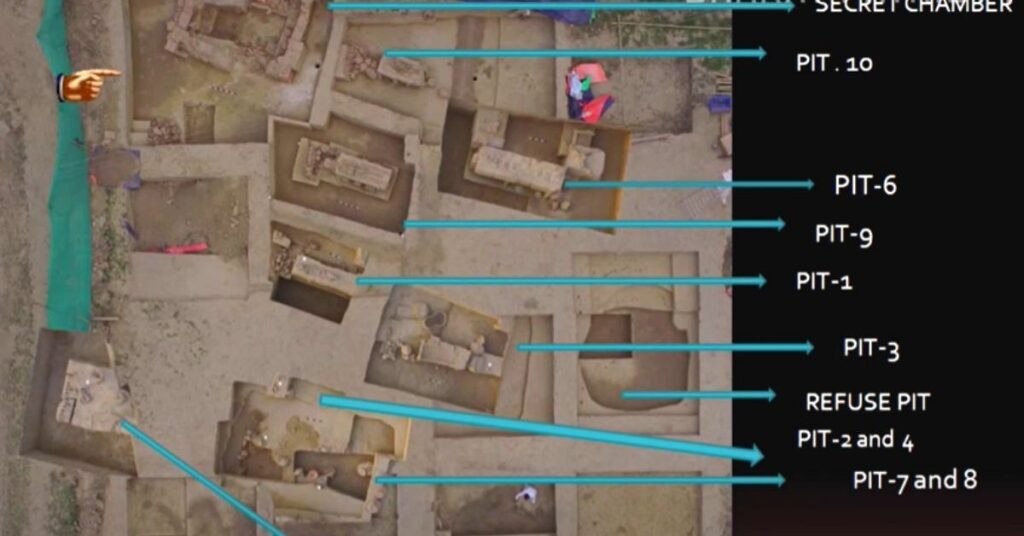
Did Sanuali coexist with the Harappan civilisation?
The archaeologists found a slew of antiques such as chariots, a torch, an antenna sword, highly decorated coffins, and helmets. The astonishingly well-preserved remains are similar to those found in the late Harappan phase.
However, the Orche-Coloured Pottery (OCP) and copper-coated items are reasons enough to dismiss that Sanauli was part of the late Harappan phase. Hence, it could be that Sanauli was another Chalcolithic culture that existed alongside Harappa.
“The 2005 excavations helped us discover pottery of different sizes, besides beads and other materials that were similar to those used in the Harappan civilisation.
However, a chariot near a coffin is not seen anywhere in the Harappan sites,” Dr Sanjay Kumar Manjul, director of the ASI’s Institute of Archaeology and in-charge of the excavation, told Outlook.
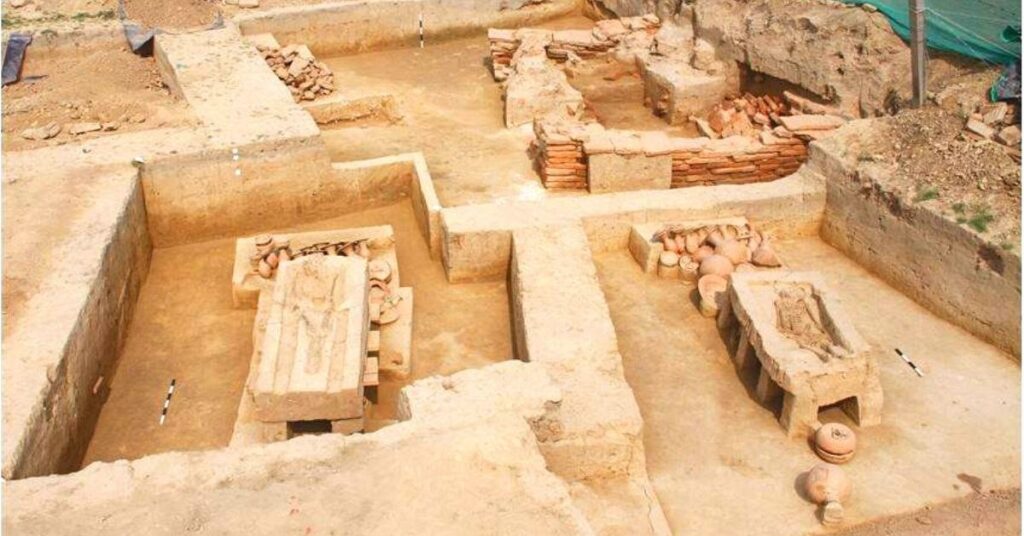
Further, the bricks found on the in-situ site are different as well, “The Harappan bricks are smaller than Sanauli, but excavators could not identify the alignment or make sense of the structure. This has left many questions unanswered,” says Disha.
Explaining the process of identifying the bricks and discovering a new element with Dr Manjul, she says, “After days of strenuous work, we noticed one brick in the structure was perfectly horizontal, and others which were falling.
This one brick gave the impression that it is supported by some sort of structure or more bricks underneath. I decided to undercut the section and we found the fourth side of the collapsed wall.
We understood that there are two layers to this structure and that it’s not a platform, but instead a walled structure. What was interesting was that two sides of the structure had collapsed inwards, whereas the third wall that I found after undercutting the section was outwards.
As the level of the base was the same as that of the burial pits, it suggested that this was a structure built in a pit, where the two sides that collapsed inwards were supported by the natural sediment and then the rest of the structure was above the ground with a wooden superstructure. We could see the heavy use of wood everywhere.”
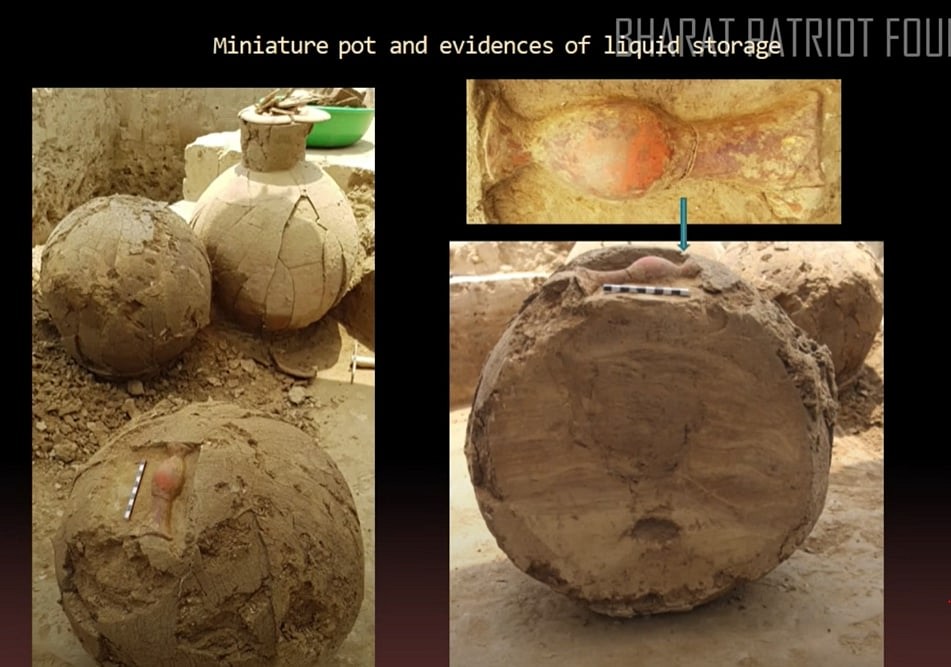
Of royalty & warfare
In 2018’s digging, the ASI team unearthed other items that gave further insight into the culture of Sanauli including warfare and the royal borough.
The fresh evidence, comprising eight burials, screams for evidence of an elite class. A decorated horn comb with a peacock motif, a copper mirror, an armlet made of agate beads, vases, and bowls are a few examples of this.
One royal coffin had a decorated lid with eight anthropomorphic figures such as headgear, and pipal leaf. A copper armour shaped like a torso was another item. Besides, ceramic pots were found next to the coffins, suggesting the possibility of rituals that were performed before the person was buried.
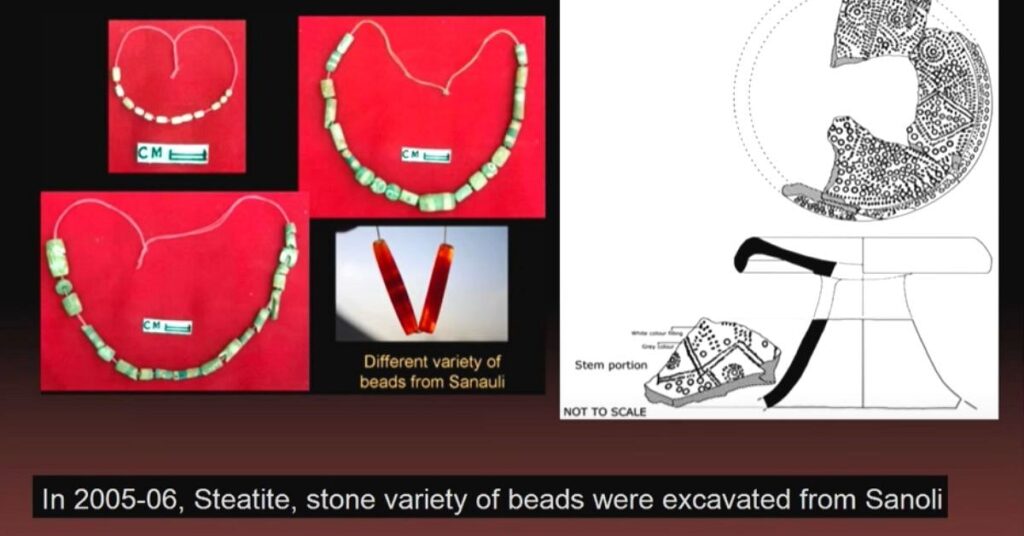
The burials also hinted that the tribe consisted of warriors who used technologically advanced weaponry. For example, the antenna sword was placed in an upright position next to the skeletons of both, males and females (yes, women also may have fought wars as per Dr Manjul). Additionally, the swords have copper-covered hilts and medial ridges, which are sturdy enough for war.
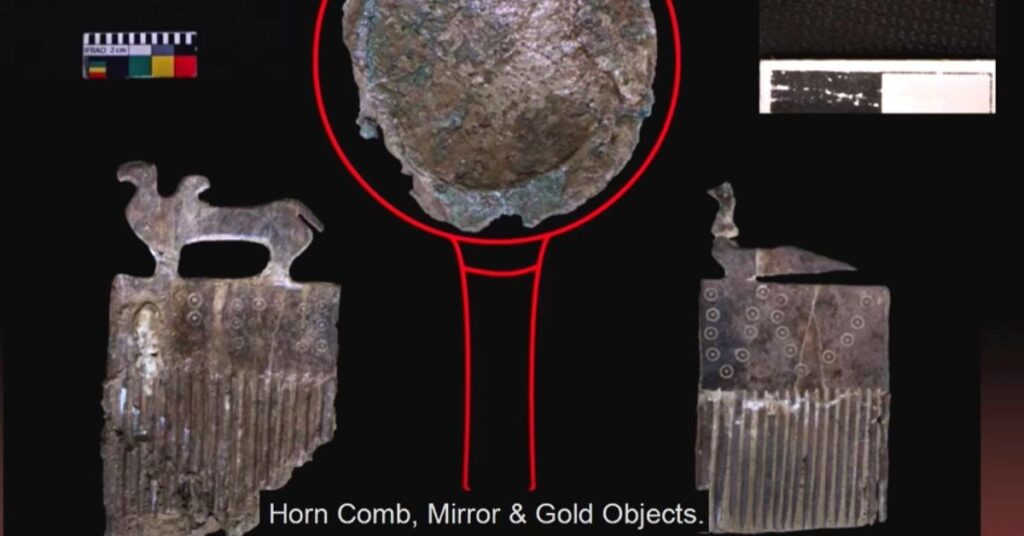
The three chariots made of wood and covered with thick copper sheets also denote wars. Unlike the ones found in Harappan culture, these chariots were smaller in size with thinner carts.
This means that they could accommodate a maximum of two people according to Dr Manjul. Hence, they weren’t used as carriers. The chariots are two-wheeled and are fixed on an axle. This was supposedly linked to the yoke of a pair of animals by a long rope.

Helmets and shields further affirm the possibility. Interestingly, the ASI team believes that the helmet could be the world’s oldest. “If you see the documentary, the excavator says ‘helmet’ or ‘copper pot’. But earlier, the excavator suggested that it was a copper helmet.
We are yet to be sure. It could be the earliest, because if it is a helmet, then no other such object predates Sanauli. The ones in the West are of later dates. But in my opinion, we should conduct more analysis,” says Disha.
Meanwhile, the shields had two gender-specific designs. The ones found next to women had steatite inlay work and men’s burials had ones with copper designs.

According to Dr Manjul, the ASI team used modern and scientific techniques such as X-Ray, Handheld XRF, 3D scanning, CT scan and drone and Magnetometer surveys to analyse the startling findings. Both Dr Manjul, as well as Disha, reiterate that more studies will be conducted to unearth specific historic events and significance in future.


